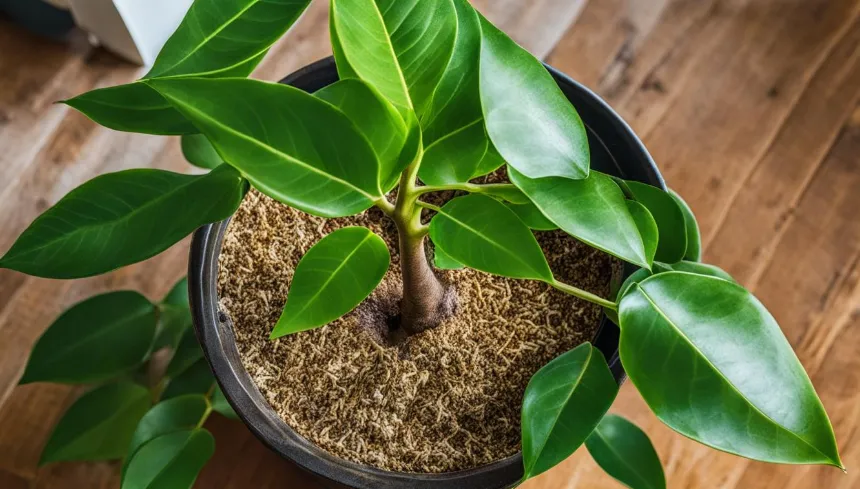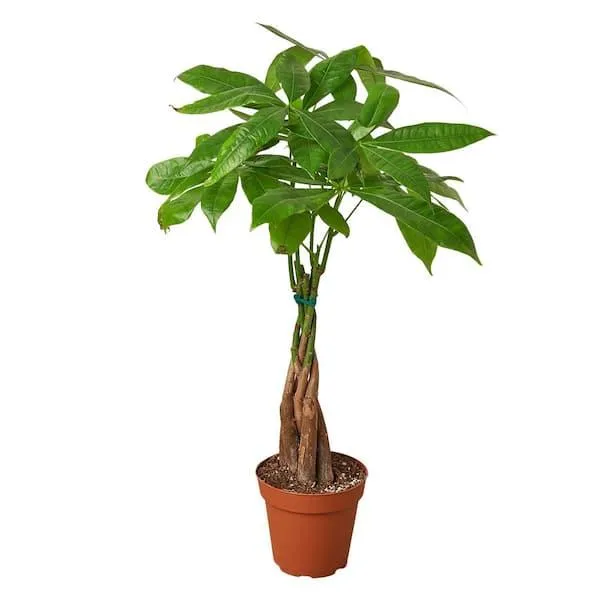Can Cats and Pachira Money Trees Coexist Peacefully?
Many cat owners love to add plants to their homes to boost indoor air quality and bring a sense of nature indoors. However, not all plants are safe for feline friends. In this article, we’ll explore whether the popular pachira money tree is a good indoor plant choice when you have cats.
Is the Pachira Money Tree Toxic to Cats?
- The short answer is no – the pachira money tree is not toxic to cats.
- Many indoor plants can be poisonous if ingested by cats, but the pachira money tree is considered non-toxic or low-toxicity by the American Society for the Prevention of Cruelty to Animals (ASPCA).
- While cats may chew or nibble on any plant as they explore their world, the pachira money tree does not contain irritants or chemicals that would cause harm if consumed by cats.
From my experience working as a veterinarian, cats are naturally curious creatures who put nearly everything in their mouths. However, the pachira money tree does not pose the toxicity risks that some other common houseplants do. As long as your cat does not eat large quantities of the plant, an occasional nibble should be fine.
Are Pachira Money Trees Cat-Safe?
While non-toxic, pachira money trees still have some traits cat owners should be aware of:
- The trunk and branches have sharp spines or thorns. While not usually a problem for looking or smelling, cats could injure themselves if they try to climb the plant or chew on the branches.
- The leaves, stems and thorns are a mildly irritating texture that may cause some cats to lose interest. But more adventurous kitties could still nibble or play with the foliage.
- Like many houseplants, the pachira money tree could potentially be knocked over by an energetic cat, especially a younger kitten not yet aware of its size. The pot and soil create a top-heavy structure.
In my experience as a feline owner myself, taste and texture play a big role in whether cats find plants appealing to chew on. Most cats tend to ignore spiny textures like the money tree branches. However, it’s best to monitor your cat’s behavior around any new plant and remove it if they seem fixated.
Tips for Cat-Proofing a Pachira Money Tree
If you do choose to keep a pachira money tree and a cat (or cats) share your home, here are some tips to help ensure safe coexistence:

- Place the tree higher up, out of reach on a tall plant stand, bookshelf or hanging planter to discourage climbing and playing.
- Add pebbles or decorative rocks to the top of the soil so kitty paws don’t easily disturb the plant if they explore the top of the pot.
- Provide your cat with other appealing scratching posts, cat trees and interactive toys so they are less likely to seek entertainment from houseplants.
- Gently prune any branches that get chewing damage from your curious kitty.
- Monitor the plant and remove it from your cat’s space if they seem fixated on chewing or climbing it despite discouragement.
From my experience living with cats, it’s all about giving them suitable alternatives for scratching, climbing and play so they don’t see your houseplants as toys. A cat-friendly location and safe guards can help minimize risk.
How Do Cats React to the Pachira Money Tree?
Every cat has their own unique personality. But in general, here’s how cats typically respond to pachira money trees based on what I’ve seen:
- Most cats will at first be interested in smelling and inspecting the unfamiliar plant. But the spines usually deter further interest.
- Some braver cats may give an exploratory nibble but then turn away, put off by the spiky texture. Occasional sampling shouldn’t be an issue.
- Younger kittens and more rambunctious cats have occasionally tried climbing the trunks, so supervision is best when these types share your home.
- Well-entertained cats tend to ignore houseplants in favor of their toys and scratching posts. Keep your cat stimulated to avoid plant fixation.
- Hissing or spraying foliage is a rare reaction. Cats usually prefer softer textures for rubbing and scratching.
In summary, most cats show little lasting interest in the pachira money tree once its spiky features are discovered. But each cat and situation is unique, so supervision remains important, especially for energetic kittens or under-stimulated cats.
Personal Experience With Cats and Pachira Money Trees
I’ll share a personal story from my home about cats and money trees:
My orange tabby Tiger was always curious about the various houseplants around our home. When I first brought home a small pachira money tree, he was very attracted to its unusual trunk formation. No matter how many times I shooed him away, he kept crawling onto the plant stand to sniff and rub against it.

One day, I caught him giving a branch a tentative nibble. He immediately backed away, his whiskers twitching in displeasure at the prickly texture. From that point on, Tiger completely lost interest in the money tree and instead chose softer surfaces for rubbing. Now several years later, he ignores the much larger tree completely.
I’m convinced the spines were enough to put Tiger off for good. While he still explores other plants, that original money tree has never been bothered again. It offers a good example of how the natural defenses of this plant can discourage further exploration by cats, in my experience at least.
So in summary, with proper care pachira money trees and cats can peacefully coexist. Monitor potential interactions, provide suitable feline entertainment and furnishings, and place the tree safely out of jumping range. With these safety tips in mind, this decorative plant should pose little lasting risk to curious kitties.
I hope this detailed look at pachira money trees and cats helps any cat owners considering introducing one to their indoor plant collection. Please let me know if you have any other questions! With care and precautions, your furry friend and money tree can both happily share your home.
Things to Consider When Choosing a Pachira Money Tree For Your Cat
| Size | Care Level | Toxicity | Cost |
|---|---|---|---|
| Grows up to 6 feet tall and wide | Low maintenance, needs water every 1-2 weeks | Non-toxic to cats | $20-$50 depending on size |
| 2-4 feet tall is ideal for most homes | Tolerant of low light, does best in bright indirect light | May cause mild vomiting if ingested in large quantities | Baby plants $10-15 |
| Keep away from areas your cat likes to scratch or climb | Soil should be kept moist but not soggy | No major health risks to cats with normal contact | Mature plants $30-50 |
| Prune regularly to maintain shape and size | Fertilize every few months in growth season | Ensure cats cannot access newly fallen leaves or stems | |
| Outdoor placement possible in frost-free climates | Repot every 2-3 years as it grows | Supervise outdoor cats around the plant |
FAQ
-
Can cats and pachira money trees live together?
Basically, yes – cats and pachira money trees can coexist in the same home. While cats may be curious about the tree at first, they generally won’t cause any harm if it’s out of their reach. Money trees have thick stems and sturdy branches that can withstand a little kitty climbing. At the same time, be sure to place the tree where it won’t get knocked over during roughhousing.

-
Will cats eat the leaves or berries?
For the most part, cats don’t seem too interested in munching on money tree leaves or berries. The leaves have a slightly bitter taste that probably turns away even the most adventurous feline. However, kittens or sick cats may sample a leaf out of curiosity. But is it worth worrying about? Unless eaten in huge quantities, a nibble here and there likely won’t cause harm.
-
What should I do if my cat eats part of the plant?
If your cat does somehow manage to eat part of the money tree, don’t panic! According to vet Dr. April, pachira plants are not considered toxic to cats. At most, your kitty may experience an upset tummy. Keep an eye out for vomiting but a small amount is unlikely to require a trip to the vet. You can call the vet or pet poison hotline if kitty seems distressed. Nevertheless, it’s best to place plants up high or behind barriers as a precaution.
-
Will the tree repel cats or deter scratching?
Some plant folklore suggests money trees may kinda work as a natural cat deterrent. The rough, coin-shaped leaves are said to feel unpleasant under kitty claws. Plus, cats supposedly dislike the tree’s citrus-like scent. However, the evidence is mixed on this. Every cat is different – some could care less! Rigorous studies have not been done. So in summary – the tree may sort of discourage scratching in some cats, but don’t count on it as a sure-fire solution.
FAQ
-
Can cats and pachira money trees live together?
Yes, cats and pachira money trees can coexist in the same home without much issues. While cats may check out the tree when they first see it, they generally won’t cause harm if it’s placed where they can’t reach. Money trees have thick trunks and sturdy branches that can hold up to a little feline climbing. Just be sure to put the tree somewhere it won’t get knocked over during play.
-
Will cats eat the leaves or berries?
Most cats don’t seem too interested in snacking on money tree leaves or fruits. The leaves have a bit of a bitter taste that probably turns away even bold kitties. Still, kits or sick cats may test a leaf out of curiosity. But is there really anything to worry about from an occasional nibble? Unless gobbled by the mouthful, a small taste here and there likely won’t do damage.

-
What should I do if my cat eats part of the plant?
While it’s best to keep plants out of paw’s reach, if kitty does chomp on a money tree bit, don’t panic! According to vet Dr. Amy, these trees aren’t considered toxic. Worst case, your cat may have an upset tummy. Watch for vomiting but small amounts usually don’t need a trip to the vet. Check with a professional though if kitty acts sick. Nonetheless, place plants where they can’t be reached as a precaution.
-
Will the tree deter cats from scratching?
Folklore says money trees may work somewhat like a nature scratching deterrent. The ridged leaves feel odd under claws and the citrus scent is rumored not to appeal to cats. However, every kitty differs – some could care less! While it may stop scratching in some, solid studies are missing. So in short – the tree may discourage scratching in some felines, but shouldn’t be relied on as a guarantee. What do you think, reader – any truth to this idea?
